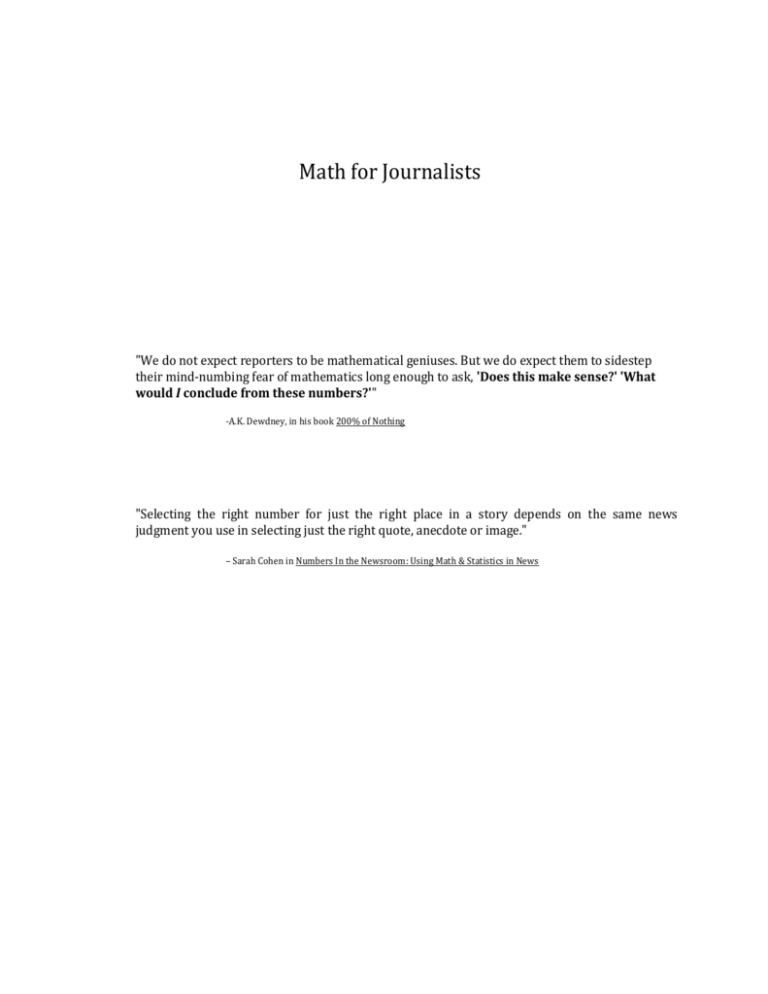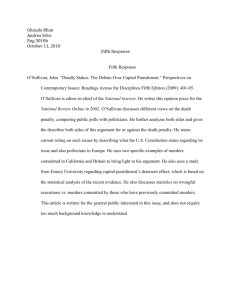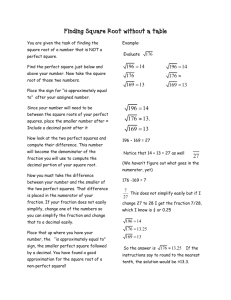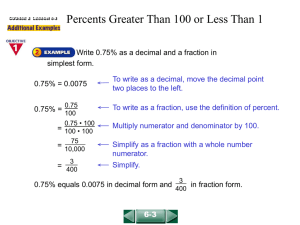Newsroom math overview
advertisement

Math for Journalists "We do not expect reporters to be mathematical geniuses. But we do expect them to sidestep their mind-numbing fear of mathematics long enough to ask, 'Does this make sense?' 'What would I conclude from these numbers?'" -A.K. Dewdney, in his book 200% of Nothing "Selecting the right number for just the right place in a story depends on the same news judgment you use in selecting just the right quote, anecdote or image." – Sarah Cohen in Numbers In the Newsroom: Using Math & Statistics in News Some reasons why we as reporters (and editors and photographers and artists) hate and fear math: There was no math required in J-school. We wear math ignorance (or “innumeracy”) as a badge of honor. We’ve already got a math nerd in the newsroom, so why bother? My source will give me all the numbers I need. Why you need to understand a few basics about math: Numbers are a summary of life. We think they imply a sense of concrete precision that they do not. Many numbers are a guess. Many numbers are an opinion. Some handy rules of thumb on writing with numbers when all else fails: Try to keep the numbers you include in a story to a minimum. Never use more than two or three numbers in a paragraph. This includes dates, times, years and spelled-out numbers. For example this sentence: "The Office of Redundancy's budget rose 48 percent in 2006, from $700.3 million to $1.03 billion in 2007." …can be more simply rewritten as: "Over the past year, the Office of Redundancy's budget grew by nearly half, to $1 billion." Similarly, avoid writing more than one paragraph in a row that contains numbers. Learn to round off decimals—DON’T just chop off decimal places. Then, round some more to make a number manageable. Know the common numbers on your beat so that you can easily place new numbers in perspective. (for example - median incomes, population, budget totals, tests scores, homicides, batting averages) Use precise language, but don’t try to make your numbers more precise than they really are. Save your numbers for graphics—bar charts, tables or even a break-out box. Use the tools you already have at your disposal. Use the calculator on your computer. Learn Excel and have it do the hard calculations for you. Also, Google has a built-in calculator. For example, if you want to divide 8,345,089 by 31, just type this into the search engine and press enter: 8345089/31 It will return this answer: 269,196.419 (rounded off) Always double check your math. Does the number make sense? Whenever you have a story with any numbers in it, print out a copy before you file it. Circle every number in it and go back and double check each one. Working with numbers Numbers on their own, without any context, tell us very little. When we’re reporting a story, and we include a number, say $9 million, we do our readers a disservice when we don’t put it in perspective. If you’re writing about a municipal property tax bill, a $9 million deficit out of a $180 million budget is fairly significant. If you’re writing about Bill Gates’ dry-cleaning bill of $9 million, that’s a drop in the bucket for a man worth nearly $27 billion. The way to put numbers into perspective is using ratios or rates—comparisons between two numbers. Fractions The most common ratio is the fraction. We use the fraction to reduce the scale of a very large number while putting it into perspective. We can take the municipal property tax deficit and express it as a fraction of the total city budget: To look at a fraction, the top number (or numerator) is compared to the larger whole (or the denominator). So our tax bill as a fraction is: 9,000,000/180,000,000 You can also express this as: 9/180 You can simplify this even further by dividing the top and bottom of the fraction by 9: 1/20 So the $9 million deficit accounts for 1/20th of the city budget. It’s only 1/3,000th of Bill Gates’ current net worth. Percents A percent is a ratio expressed as a fraction of 100. It’s the same thing as a fraction. 1/20th is the same as 5 percent or, as a decimal, .05. How do you figure this out? Go to your calculator and type in 1 divided by 20. That will give you .05. You can either multiply that by 100 or just move the decimal point two spots to the right. So how do you figure a percent when you’re dealing with something bigger? Step 1: Determine the base, or total number, of what you are looking at, or the sum of all the numbers involved. Step 2: Divide the portion you’re looking at by the base. Step 3: Multiply that number by 100 to get the percentage Step 4: Round and simplify You want to know the percentage of how many times a basketball player has hit his three-point shots over the season. You counted that he sank 37 baskets from the three-point line and he missed 61 shots. Step 1: The base is the total number of attempts = 37 baskets + 61 missed shots = 98 Step 2: Rate = 37 out of 98 = 37/98 = .37755102… Step 3: Percent = .37755102… x 100 = 37.755102… percent Step 4: Round and simplify = 37.8 percent, or more than a third of his chances resulted in baskets. If you want to reverse a percentage to get a simple fraction: Say you start with 25 percent. Write it as a fraction: 25 out of (per) 100 (cent), or 25/100. You want to find the least common denominator, or the largest whole number that will go into both the top and the bottom. In this case, that number is 25, divide the top and bottom by 25 and you get ¼ or 1 out of 4. Rates and ratios Rates and ratios are particularly useful in comparing unlike things, in leveling the playing field and in making sense out of very small numbers. For instance, crime rates can help you compare the amount of crime in two very different places with different populations, by putting them on equal footing. In 2005, New York City had 539 murders. Paterson had 20 murders. Which town had the higher murder rate, or the most murders per capita (or resident)? You figure the rate by dividing the number of murders by the total population. Paterson’s population in 2005 was 151,200. So 20 murders divided by 151,200 residents equals .000132275 murders per city resident. That doesn’t really make sense, because it’s difficult for us to conceptualize what .000132275 murders looks like. So in these kind of cases (and murder rates in general), we figure the rate per 100,000 city residents. Step 1: Figure the base Step 2: Figure the proportion (the portion divided by the base) Step 3: Multiply the proportion by 100,000 Step 4: Round to the nearest whole number. For Paterson, that looks like this: Step 1: The base is 151,200 residents. Step 2: The proportion = 20/151,200 = .000132275 Step 3: .000132275 x 100,000 = 13.2275 murders per 100,000 residents Step 4: 13 murders per 100,000 people in Paterson in 2005. How did New York look that year? Step 1: New York’s population in 2005 was 8,115,690 Step 2: 539 murders per 8,115,690 = 539/8,115,690 = 6.641456240935767630355521218775e-5 murders per New Yorker, or a number so small I don’t even know how to express it. But your calculator does. Step 3: 6.641456240935767630355521218775e-5 x 100,000 = 6.641456241 murders per 100,000 residents Step 4: 7 murders per 100,000 people in New York in 2005. When it came to getting killed in 2005, you would have been almost twice as likely to be murdered in Paterson (13 per 100,000) than in New York City (7 per 100,000). Percent change Percent change is one of the most misunderstood numbers in reporting, yet it’s also one of the easiest to calculate. Last year, 6,871 voters cast ballots for school board members. This year, 7,487 voters made it to the polls. What’s the percent change? Step 1: Find the difference in the numbers. To do this, subtract the old number from the new number. (It doesn’t matter which one is bigger, only which one is more recent; this can be a negative number), or New – Old = Difference Step 2: Divide the difference by the old number, or Difference/Old Step 3: Multiply by 100 to get the percent change Step 4: Round off and simplify So in this voting example: Step 1: 7,487 – 6,871 = 616 Step 2: 616/6,871 = .089652 Step 3: .089652 x 100 = 8.9652 percent Step 4: Round and simplify: 9 percent or, nearly a tenth The mnemonic device I use to remember this is “NOO!” It stands for “New minus Old divided by Old”. (New-Old)/Old = percent change Averages, means, medians and modes When summarizing a large group of numbers, there are several different ways to describe it. Each way can potentially tell a different story. What is commonly called the average number is also known as the mean. This is a simple average that is calculated by adding up a list of numbers and dividing that sum by the total count. The median value is the middle value in a list of numbers. To find this, put your list of numbers in order from lowest to highest and find the middle number. If you have an even number of numbers, figure the average of the two numbers in the center of the list. The mode is the most common value in a list of numbers. Why does all this matter? You need to understand these descriptions and what they represent so you are prepared to deal with sources who might try to manipulate you. In the 1994-1995 Major League baseball strike, one of the largest bones of contention was the issue of salaries. The owners argued that the mean salary for players was $1.2 million. But the median annual salary in the league was $350,000, and the mode salary was $100,000. Why was there a difference? Which one would you report, and why? Common math pitfalls Packing too many numbers into a story. You can almost see the readers’ eyes glaze over when they try to wade through a story that’s sinking in a morass of numbers. Be judicious about what numbers you use. The illusion of false precision. Numbers are usually out of date the second they’re collected, and they are often based on small samples, rounded numbers and guesses of all kinds. For your stories, a rounded number is sometimes more accurate than the number with eight decimal places Overcooking. You can’t simply average a set of averages and expect to get a number that means anything. In last year’s school budget, you see that various positions made, on average, the following salaries: Teachers: $35,000 Classroom aides: $19,000 Administrators: $65,000 What’s the average salary in the district? Your first inclination might be to just average these together, or add the three numbers together and divide by three. That would give you an “average” of $39,666. That would be wrong, because it doesn’t take into account how many people work in each of these jobs. There are 35 teachers in the district that make an average of $35,000. There are 10 classroom aides that make an average of $19,000. There are 5 administrators that make an average of $65,000. To get a weighted average: 35 x 35,000 = 1,225,000 10 x 19,000 = 190,000 5 x 65,000 = 325,000 1,225,000+190,000+325,000 = 1,740,000 1,740,000 / 50 school employees = $34,800, the true average salary in the district. Losing sight of the base. It’s difficult to quote a percentage (or percent change), when you’re describing a group of numbers that are fewer than 100. Smaller numbers can generate big percentages. It might create the illusion of a greater amount of change than is actually happening. Very few of your sources know how to do math either. A good example from Ashley Kindergan: a municipal official lectured the city council about rising water rates. The water rate in 2005 was $5. The water rate in 2006 was $7. The water rate in 2007 was $9. The rate increased by 40% from 2005 to 2006, and it rose by 29% from 2006 to 2007. Therefore, the official said, the rate had increased by 69 percent from 2005 to 2007. He simply added the yearly percent changes. That doesn’t work! He needed to do the total percent change from 2005 to 2007: (95)/5 = 80% That’s a big difference from 69 percent. Ignoring the little voice inside your head. Sometimes when a source hands us a number, we take it at face value, even when it flies counter to everything else we know. Make sure a number stands up to common sense and your gut check. For you to follow-up on your own, I highly recommend that you buy, read and bookmark Sarah Cohen’s Numbers In the Newsroom. You can purchase it from IRE’s website: http://ire.org/store/books/math.html I owe a great debt to The Washington Post’s Sarah Cohen, IRE’s David Donald and Scott Thurm of the San Jose Mercury News, whose tip sheets and books I used (stole) extensively here.





